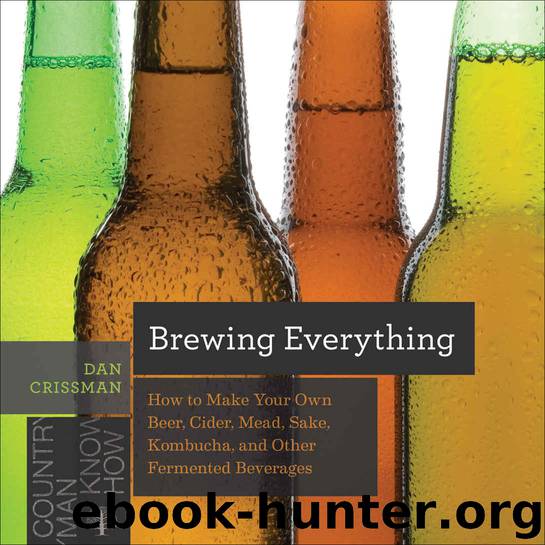Brewing Everything: How to Make Your Own Beer, Cider, Mead, Sake, Kombucha, and Other Fermented Beverages (Countryman Know How) by Dan Crissman

Author:Dan Crissman [Crissman, Dan]
Language: eng
Format: epub
Publisher: Countryman Press
Published: 2018-06-28T23:00:00+00:00
THE PROCESS
First, select the apples you want to use for your cider. Mix various types of sweet, aromatic, and tart varieties to achieve your desired flavor. Avoid damaged or badly bruised fruit, as it can harbor bacteria or other unwanted microbes, but at the same time, don’t be too much of a stickler for perfect specimens. The apples are all going to end up as pulp anyway.
If you pick the apples fresh, let them sit for a few days after picking. This is referred to as “sweating” the apples, giving them time to further ripen and reduce their overall water content. This may feel like a skippable step, but it can make a huge difference in the quality of the juice. You’ll get richer flavors and more concentrated juice. It’s worth waiting a day or so even with store-bought apples, too. You’ll know when they are ready when you can push lightly and leave a small indentation on the apple, but it still has structural integrity.
Once you’re ready to grind, wash the apples thoroughly in cold water to remove any dirt or residue. Don’t use soap or any other chemical sanitizers; just plain old water will do the trick here. When the apples are clean, fill the sink with fresh water and add in your apples for one final quality test. Apples that float are healthy and ready for use. Apples that sink to the bottom should be tossed.
Now it’s time to grind. If you are using an industrial-grade mill for this, you don’t need to cut up the fruit at all; just drop it in whole. (Also, you are a badass.) But for newbies using a food processor, you’ll need to cut the fruit into slightly smaller pieces to get an even grind. Don’t grind the fruit too fine, though. You want somewhere between baby food and chunky applesauce. It will look brown and very unappetizing at this point, but don’t worry. That’s normal.
When you’ve got the right consistency, collect the pomace into a bucket and keep grinding until all of your apples have become pulp. If you are using multiple apple varieties—which is strongly encouraged—it’s worth taking the time to grind and press each one separately. This will allow you to blend the various juices to your taste and give you far greater control in determining the final flavor of your cider.
To juice, add the pomace to the nylon bag inside your press. Position a cleaned and sanitized bucket underneath the press to catch the runoff from the spout. Once it starts flowing, liquid will pour out at a steady clip, so make sure you have another clean bucket handy for when the first fills up. Turn the crank on the press slowly at first, giving the juice time to collect at the bottom before hitting it with more pressure. This will be a slow process and requires patience, lest you leave too much of the juice behind in the fruit. The longer you spend pressing, the greater your juice yield will be.
Download
This site does not store any files on its server. We only index and link to content provided by other sites. Please contact the content providers to delete copyright contents if any and email us, we'll remove relevant links or contents immediately.
101 Whiskies to Try Before You Die by Ian Buxton(44809)
World's Best Whiskies by Dominic Roskrow(44746)
Whiskies Galore by Ian Buxton(41885)
Craft Beer for the Homebrewer by Michael Agnew(18145)
Right Here, Right Now by Georgia Beers(4129)
Not a Diet Book by James Smith(3341)
Water by Ian Miller(3129)
The Coffee Dictionary by Maxwell Colonna-Dashwood(3067)
Kitchen confidential by Anthony Bourdain(3015)
Coffee for One by KJ Fallon(2571)
Smuggler's Cove: Exotic Cocktails, Rum, and the Cult of Tiki by Martin Cate & Rebecca Cate(2474)
Superfood Smoothie Bowls: Delicious, Satisfying, Protein-Packed Blends that Boost Energy and Burn Fat by Chace Daniella(2390)
Talking as Fast as I Can by Lauren Graham(2387)
Beer is proof God loves us by Charles W. Bamforth(2376)
Bourbon: A Savor the South Cookbook by Kathleen Purvis(2246)
A Short History of Drunkenness by Forsyth Mark(2236)
Eat With Intention by Cassandra Bodzak(2157)
Cocktails for the Holidays by Editors of Imbibe magazine(2082)
Colombia Travel Guide by Lonely Planet(2066)
